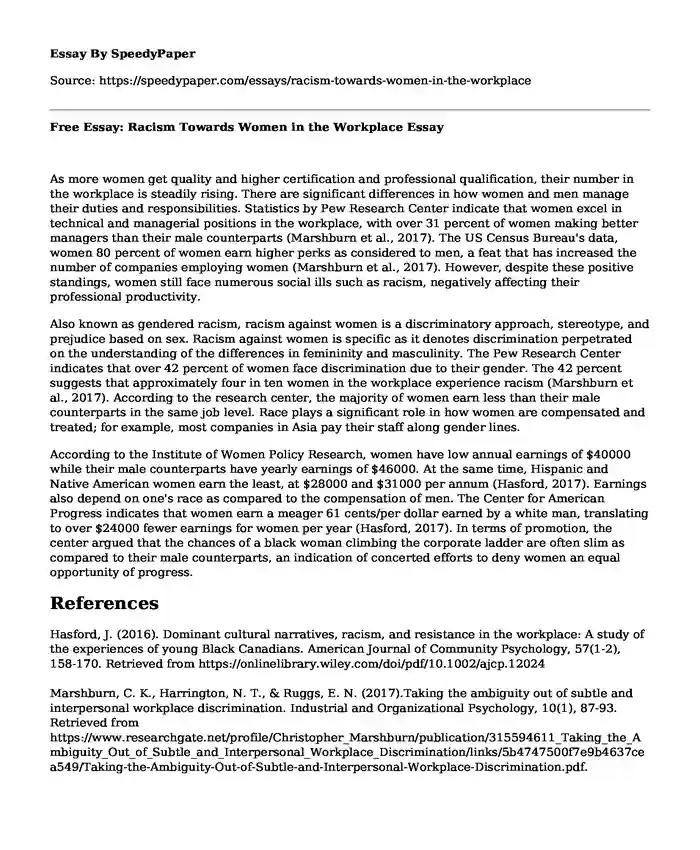As more women get quality and higher certification and professional qualification, their number in the workplace is steadily rising. There are significant differences in how women and men manage their duties and responsibilities. Statistics by Pew Research Center indicate that women excel in technical and managerial positions in the workplace, with over 31 percent of women making better managers than their male counterparts (Marshburn et al., 2017). The US Census Bureau's data, women 80 percent of women earn higher perks as considered to men, a feat that has increased the number of companies employing women (Marshburn et al., 2017). However, despite these positive standings, women still face numerous social ills such as racism, negatively affecting their professional productivity.
Also known as gendered racism, racism against women is a discriminatory approach, stereotype, and prejudice based on sex. Racism against women is specific as it denotes discrimination perpetrated on the understanding of the differences in femininity and masculinity. The Pew Research Center indicates that over 42 percent of women face discrimination due to their gender. The 42 percent suggests that approximately four in ten women in the workplace experience racism (Marshburn et al., 2017). According to the research center, the majority of women earn less than their male counterparts in the same job level. Race plays a significant role in how women are compensated and treated; for example, most companies in Asia pay their staff along gender lines.
According to the Institute of Women Policy Research, women have low annual earnings of $40000 while their male counterparts have yearly earnings of $46000. At the same time, Hispanic and Native American women earn the least, at $28000 and $31000 per annum (Hasford, 2017). Earnings also depend on one's race as compared to the compensation of men. The Center for American Progress indicates that women earn a meager 61 cents/per dollar earned by a white man, translating to over $24000 fewer earnings for women per year (Hasford, 2017). In terms of promotion, the center argued that the chances of a black woman climbing the corporate ladder are often slim as compared to their male counterparts, an indication of concerted efforts to deny women an equal opportunity of progress.
References
Hasford, J. (2016). Dominant cultural narratives, racism, and resistance in the workplace: A study of the experiences of young Black Canadians. American Journal of Community Psychology, 57(1-2), 158-170. Retrieved from https://onlinelibrary.wiley.com/doi/pdf/10.1002/ajcp.12024
Marshburn, C. K., Harrington, N. T., & Ruggs, E. N. (2017).Taking the ambiguity out of subtle and interpersonal workplace discrimination. Industrial and Organizational Psychology, 10(1), 87-93. Retrieved from https://www.researchgate.net/profile/Christopher_Marshburn/publication/315594611_Taking_the_Ambiguity_Out_of_Subtle_and_Interpersonal_Workplace_Discrimination/links/5b4747500f7e9b4637cea549/Taking-the-Ambiguity-Out-of-Subtle-and-Interpersonal-Workplace-Discrimination.pdf.
Cite this page
Free Essay: Racism Towards Women in the Workplace. (2023, Apr 10). Retrieved from https://speedypaper.net/essays/racism-towards-women-in-the-workplace
Request Removal
If you are the original author of this essay and no longer wish to have it published on the SpeedyPaper website, please click below to request its removal:
- Free Essay Example on Managerial Economics
- Advertisement Analysis Essay Sample
- Drugs in Korea Essay Sample
- Free Essay with a Critical Analysis of The Once Were Warriors Movie
- Essay Example on Offshore Oil and Gas Drilling
- Essay Example on Parents Smoking in the Presence of Children
- Kirkpatrick Chapel's Role in an Environments Narrative - Essay Example
Popular categories





